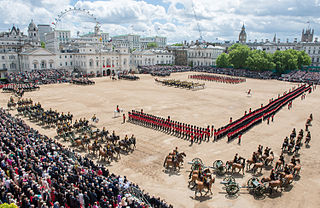
Trooping the Colour is a ceremony performed by regiments of the British Army. It has been a tradition of British infantry regiments since the 17th century, although its roots go back much earlier. On the battlefield, a regiment's colours, or flags, were used as rallying points. Consequently, regiments would have their ensigns slowly march with their colours between the ranks to enable soldiers to recognise their regiments' colours.

Household Division is a term used principally in the Commonwealth of Nations to describe a country's most elite or historically senior military units, or those military units that provide ceremonial or protective functions associated directly with the head of state.
The Household Cavalry (HCav) is made up of the two most senior regiments of the British Army, the Life Guards and the Blues and Royals. These regiments are divided between the Household Cavalry Regiment stationed at Kiwi Barracks in Wiltshire and the ceremonial mounted unit, the Household Cavalry Mounted Regiment, garrisoned at Hyde Park Barracks in London. The Household Cavalry is part of the Household Division and is the Queen's official bodyguard. Although the Household Cavalry Regiment is armoured, it is not part of the Royal Armoured Corps.
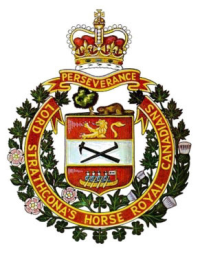
Lord Strathcona's Horse (LdSH[RC]) is a regular armoured regiment of the Canadian Army. Currently based in Edmonton, Alberta, the regiment is part of 3rd Canadian Division's 1 Canadian Mechanized Brigade Group. Members of the regiment are commonly called Strathconas or Strats as a short form. It was one of the last regiments in the British Empire to be created and raised by a private individual, Donald Alexander Smith, 1st Baron Strathcona and Mount Royal.

Guard mounting, changing the guard, or the changing of the guard, is a formal ceremony in which sentries performing ceremonial guard duties at important institutions are relieved by a new batch of sentries. The ceremonies are often elaborate and precisely choreographed. They originated with peacetime and battlefield military drills introduced to enhance unit cohesion and effectiveness in the late 17th and early 18th centuries.

The Blues and Royals (RHG/D) is a cavalry regiment of the British Army, part of the Household Cavalry. The Colonel-in-Chief is Queen Elizabeth II and the Colonel of the Regiment is Anne, Princess Royal. It is the second-most senior regiment in the British Army.
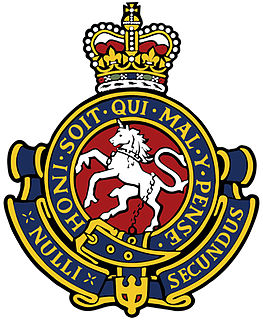
The Governor General's Horse Guards is an armoured reconnaissance regiment in the Primary Reserve of the Canadian Army, part of 4th Canadian Division's 32 Canadian Brigade Group. Based in Toronto, it is the most senior reserve regiment in Canada, and the only household cavalry regiment of Canada's three household units.

The Queen's Guard, British Guards, and Queen's Life Guard are the names given to contingents of infantry and cavalry soldiers charged with guarding the official royal residences in the United Kingdom. The British Army has regiments of both Horse Guards and Foot Guards predating the English Restoration (1660), and since the reign of King Charles II these regiments have been responsible for guarding the Sovereign's palaces. The Guards are fully operational soldiers.

The Life Guards (LG) is the senior regiment of the British Army and part of the Household Cavalry, along with the Blues and Royals.

The Royal Canadian Dragoons (RCD) is the senior armoured regiment of the Canadian Army by precedence. It is one of three armoured regiments in the Regular Force and forms part of the Royal Canadian Armoured Corps.

The 4th Princess Louise Dragoon Guards is an inactive armoured regiment of the Canadian Militia / Canadian Army, currently on the Supplementary Order of Battle.
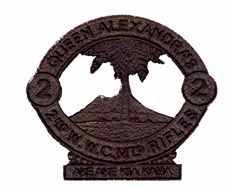
Queen Alexandra's Mounted Rifles (QAMR) is an armoured regiment of the New Zealand Army and forms part of the Royal New Zealand Armoured Corps. The regiment was formed in 1864 and is currently an armoured cavalry unit equipped with NZLAV.

Horse Guards is a historic building in the City of Westminster, London, between Whitehall and Horse Guards Parade. It was built in the mid-18th century, replacing an earlier building, as a barracks and stables for the Household Cavalry, later becoming an important military headquarters. Horse Guards functions as a gatehouse giving access between Whitehall and St James's Park via gates on the ground floor. It originally formed the entrance to the Palace of Whitehall and later St James's Palace; for that reason it is still ceremonially defended by the Queen's Life Guard. Although still in military use, part of the building houses the Household Cavalry Museum which is open to the public.

Public duties are performed by military personnel, and usually have a ceremonial or historic significance rather than an overtly operational role.

The Household Cavalry Mounted Regiment (HCMR) is a cavalry regiment of the British Army tasked primarily with ceremonial duties. Part of the Household Division, it is classed as a regiment of guards, and carries out mounted ceremonial duties on State and Royal occasions. The HCMR is one of two operational units that form the Household Cavalry (HCav), the other being the Household Cavalry Regiment (HCR), a formation reconnaissance regiment, with front-line combat duties.
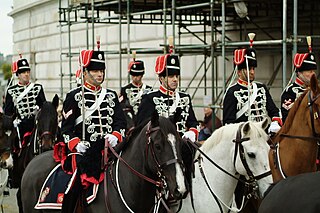
The Light Cavalry HAC is a British army unit that is a part of the Honourable Artillery Company (HAC). Established in 1861 as an active military unit, the Light Cavalry was reestablished in 1979 as a ceremonial unit for special events.
The 4th Troop of Horse Guards was the Scottish unit within the Horse Guards Regiment. It was part of the United Kingdom military establishment from 1709 to 1746, but before the Union of the Parliaments, it had been an independent unit in Scotland, sometimes referred to in modern works as the Scots Troop of Horse. The unit's establishment is usually dated to 1661, although its antecedents extend back to the fifteenth century.

A dragoon helmet was an ornate style of metal combat helmet featuring a tall crest; they were initially used by dragoons, but later by other types of heavy cavalry and some other military units. Originating in France in the second half of the 18th century, it was widely imitated by other European armies and was last used in combat in 1914. Some military units continue to wear this style of helmet for parades and other ceremonial duties.
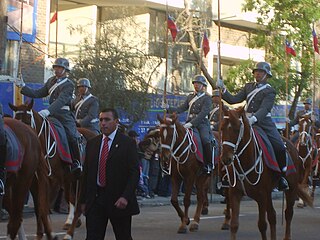
The 1st Cavalry Regiment "Grenadiers" is the senior cavalry regiment of the Chilean Army, which serves as the Horse Guards unit providing the ceremonial escort in parades and ceremonies to the President of Chile, the Supreme Commander of the Chilean Armed Forces. It provides the guard during flag raising ceremonies monthly in Santiago, the national capital. Together with the 3rd Cavalry Regiment "Hussars" it forms the remaining mounted components of the army in active service.

Military bands in the United Kingdom are the musical units that serve for protocol and ceremonial duties as part of the British Armed Forces. They have been the basis and inspiration for many military bands in the former British Empire and the larger Commonwealth of Nations as well as musical organizations in other countries. Military musical units with British influence include United States military bands, the Japan Ground Self-Defense Force Music Corps and the Military Band of Athens. British military bands are controlled by the military music departments of the three services that compose the armed forces. These include the Royal Marines Band Service, the Royal Corps of Army Music, and the Royal Air Force Music Services. British style brass bands and carnival bands were then and are currently inspired by the British Armed Forces and its brass bands, especially of the Army's regular and reserve formations, as they follow a similar format as it relates to brass and percussion instruments.



















